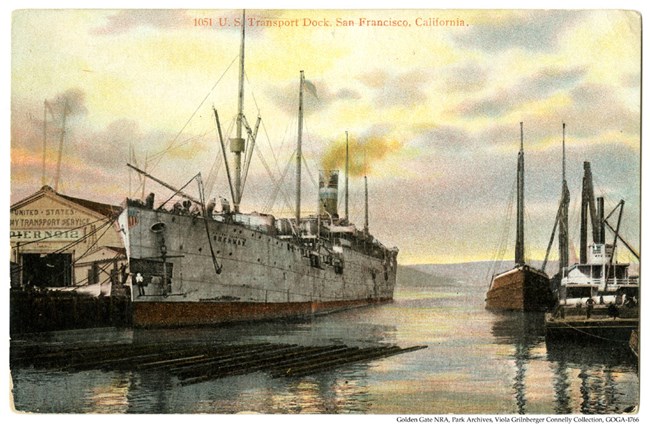|
Although not much is known about Viola Connelly, the archival collection she donated to the Presidio Army Museum in 1974 speaks volumes about the Golden Gate National Recreation Area's past. Prominently featured is a panoramic photograph taken of the Cliff House from Ocean Beach. The establishment was owned by Adolph Sutro, a Prussian-born engineer who made his fortune in Nevada during the Comstock Lode Silver Rush. The Cliff House pictured in the Connelly collection was formally opened in 1896 after the previous structure burned to the ground on Christmas Day in 1893. Sarcastically referred to as "The Gingerbread Palace" by one San Franciscan, the grand Victorian building was designed by Emile Lemme and C.J. Colley and entertained both tourists and citizens of the city. In 1907, it also succumbed to fire, nine years after the death of Adolph Sutro. 
Golden Gate NRA, Park Archives, Viola Grilnberger Connelly Collection, GOGA-1766 
Golden Gate NRA, Park Archives, Viola Grilnberger Connelly Collection, GOGA-1766 Also included in the collection are ten hand-tinted postcards of ships used to transport troops from San Francisco to ports in Japan, Hawaii, Cuba, and the Philippines. One such postcard features the USAT Sherman. Originally built as the freighter Mobile by Harland & Wolff as part of four sister ships for the African Steamship Company (Elder Dempster & Company), the ship was chartered and purchased by the Atlantic Transport Line (ATL) in October of 1896. Captained by Sydney Layland, the ship made 44 voyages to New York for the ATL between 1892 and 1897. In 1898, with five other vessels, the Mobile was called upon by the U.S. Government for service as transport ships during the Spanish American War. For this service, the Mobile was renamed the USAT (United States Army Transport) Sherman. The Army Transport Service (ATS) was organized in late 1898 as part of the Army Quartermaster Department after commercial shipping and naval resources were found deficient. Working in conjunction with civilian railroads and the maritime industry, the ATS dominated San Francisco ports that served as the main point of troop embarkation during the Spanish American War. Since the USAT Sherman was already equipped to carry livestock, the ship was retrofitted to carry cavalrymen and could accommodate 80 officers, 1,000 men, and 1,000 horses. During her time in the service, the USAT Sherman transported the 16th Pennsylvania, the 6th Illinois, the 8th Ohio, and the 9th Illinois Volunteer Infantry Regiments. The ship's return voyage to San Francisco from the Philippine Islands with California's volunteer infantry regiments in 1899 was the first in the city to be heralded by wireless transmitter. In addition to the ship's involvement in the Spanish American War, the USAT Sherman served in the Philippine American War, the Boxer Rebellion, and World War I. 
Golden Gate NRA, Park Archives, Viola Grilnberger Connelly Collection, GOGA-1766 The most striking facet of this collection are the photographs depicting the U.S. Army's presence in San Francisco in the wake of the 1906 Earthquake and Fire. On April 18, 1906, one of the largest earthquakes in California history erupted along the San Andreas Fault at 5:12 a.m. The earthquake reduced San Francisco to rubble which fed devastating fires that raced through the city in the earthquake's aftermath. Martial law was quickly declared. The United States Army, overseen by General Frederick Funston, took command in cooperation with city officials, the Red Cross, and volunteers to provide shelter, medical attention, and sanitation services for refugees in camps that were formed in parks and on streets across the city. 
Golden Gate NRA, Park Archives, Viola Grilnberger Connelly Collection, GOGA-1766 
Golden Gate NRA, Park Archives, Viola Grilnberger Connelly Collection, GOGA-1766 For more information visit: Cliff House/Sutro 1906 Earthquake and Fire |
Last updated: February 28, 2015
